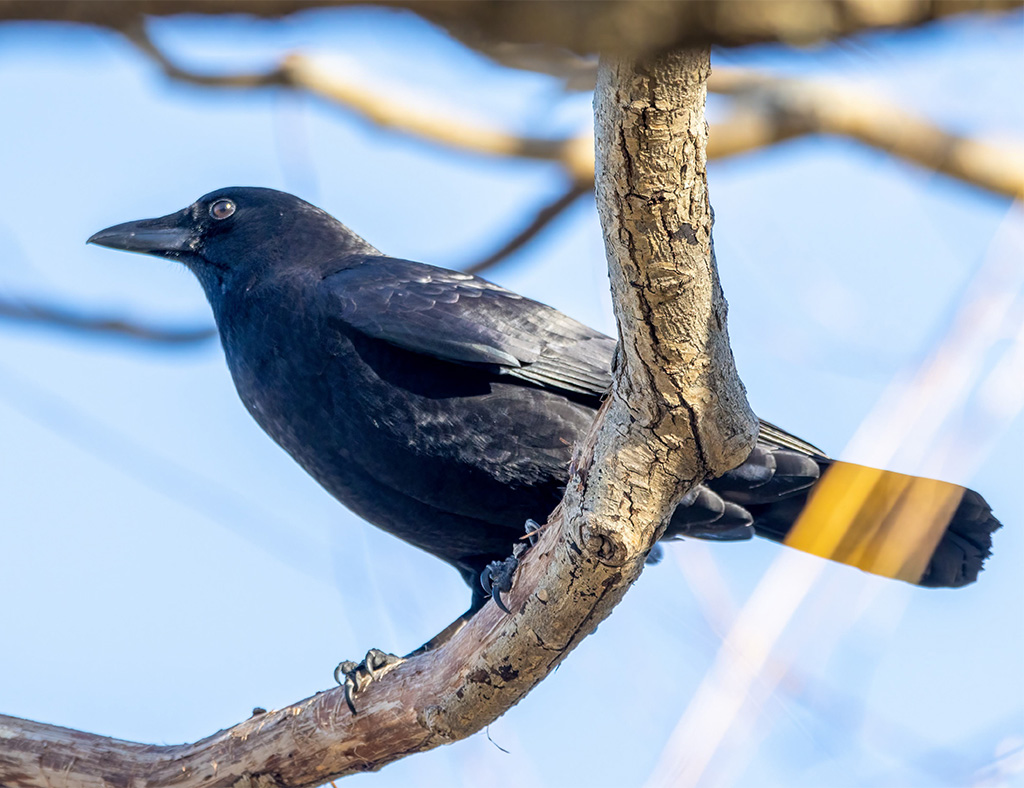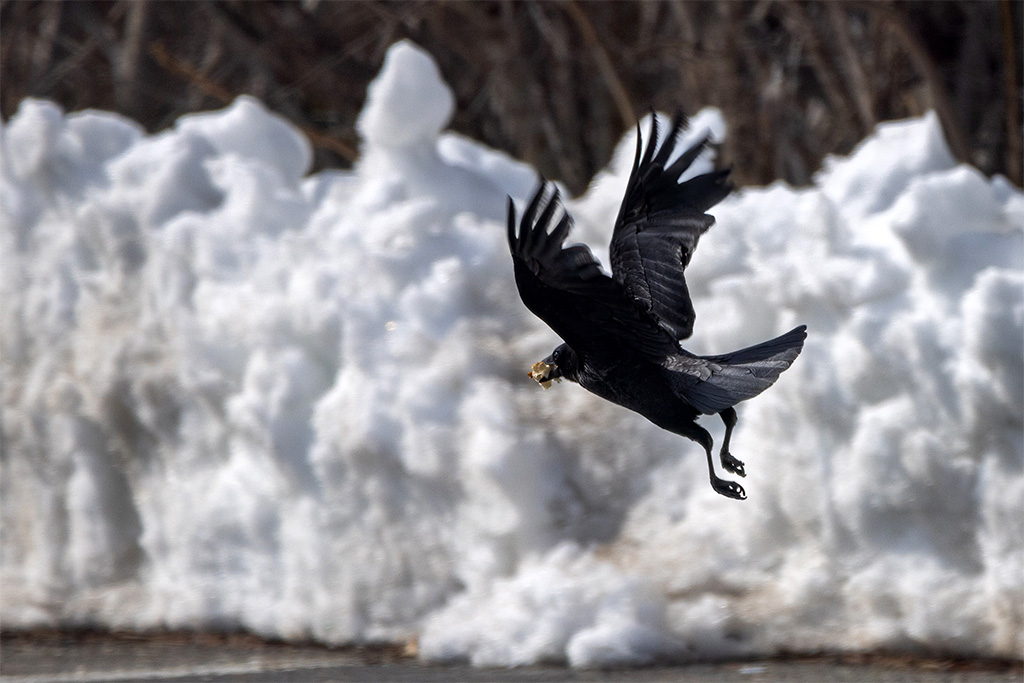Crows can indeed be scary smart

A crow scavenges food in March 2021. (Photo: Richard George)
American crows (Corvus brachyrhynchos) are found throughout most of our nation. In Massachusetts, you can find crows in urban and rural areas, in fields and along the coast. Crows are among the smartest animals in the world, their intelligence on par with that of chimpanzees. Because they fly, crows need to be lightweight; however, a crow’s brain accounts for almost 2 percent of its body mass, similar to that of humans.
Many people have anecdotes about crow intelligence, and I am one: I once watched a squirrel dart off with a peanut from a bird feeder. An attentive crow in an overhead branch watched, too. The squirrel buried the peanut in the grass about 20 feet from the feeder. After the squirrel scampered away, the crow flew to the spot, dug up the peanut and flew away with it.

A crow calls to alert other crows. (Photo: Richard George)
As you can tell, crows are clever omnivores, eating just about anything they can find – including farmers’ corn, which is why ancient Japanese farmers, Native Americans, the Greeks and Romans all made versions of scarecrows, without much success, to prevent crop losses from crows. Crows tend to walk on the ground, looking for food in the top 2 inches of soil where they might find seeds, nuts, earthworms or grubs. They will also steal food from dog dishes, dine on carrion, dig for clams, forage in garbage dumps, collect nuts from bird feeders and so much more. If there is food around, crows will figure out a way to get at it. Insects, frogs, fish, bird eggs, carrion and garbage make up about one-third of their diet; plants, such as corn or waste grains in harvested fields, make up the other two-thirds. During the winter, crows survive mostly on waste grain and what they can scavenge. From spring through summer, crows eat mostly worms, insects and other invertebrates. One crow often acts as a lookout while other crows feed.

A crow flies above North Cambridge in December. (Photo: Richard George)
Crow anecdote 2: When I was in elementary school in southeastern Alaska, our family saved the heels of bread to feed crows. If we saw one out the window, we’d grab the bread stash and head outside, scattering torn bits onto the ground. The one crow we spied would soon summon a huge flock of birds to the feast. Our dog liked to scatter the flock, but the crows outsmarted her – one crow flew just above the dog’s nose and led her in a loop around the edge of a ballfield away from the feeding birds. When the crow finished the loop, a second crow took over and led the dog around the field again.

In February 2022, a crow walks across ice in the Mystic River near Ten Hills, Somerville. (Photo: Richard George)
Crows learn quickly and pass on their knowledge for generations. Researchers at the University of Washington wore masks while they trapped, banded and released crows on the school’s campus. The crows were not harmed, but the experience was nonetheless frightening for the birds. From then on, whenever a researcher donned the mask and walked across the campus, the crows raised an alarm. Once, the researcher even wore the mask upside down – and the crows tilted their heads upside down to look at the face, then raised an alarm. When the researchers wore different masks, the crows did not react. Today, 17 years later, once or twice a year, the researchers continue to wear the mask on campus. Perhaps not surprisingly, the crows react in the same way they did 17 years ago – dive bombing the researcher and making alarm calls. When young crows see the mask wearer for the first time, they observe the behavior of older crows and learn that the masked intruder is bad news.

A crow tries to stay warm in North Cambridge in February 2022. (Photo: Richard George)
Crows are social and form close-knit family groups that stay together for up to five generations. The female lays about four or five eggs in May or June. Some young female birds stay with the parents for up to four years (the equivalent of about two decades in human years). These young birds help build and clean the nest and feed their mother while she incubates the eggs, which hatch in about 18 days. The parents feed the chicks for five weeks, and then the young forage with the parents. There are not many birds that work together every day like a family of crows.

Crows have a thick black beak that enables them to manipulate and pick up small objects. (Photo: Richard George)
About an hour before sunset in November through March, crows begin to fly in from all directions to a stand of trees, which will be their roosting spot for the night. Some crows may fly 50 miles to reach the night roost. Crows feel there is safety in numbers overnight, but at first light they disperse to their daytime foraging areas. In February or March, mated pairs leave the roosts for their home territories, where they begin building a nest. Unmated birds continue to use the roost for a few more weeks.

A crow scavenges in the winter in Quincy. Crows hide surplus food to help in times of scarcity. (Photo: Richard George)
When a crow finds the dead body of another crow, it alerts other crows. The birds gather and become quite noisy. Researchers think the discussion helps crows learn about threats, locations and predators to stay away from in the future.
Some scientists think the cerebral demands of group living led to the development of larger brains in humans. Crow behavior and brain size seems to support to this idea. Crows have evolved to be both clever and dutiful family members, suggesting also that humans are not as unique as we like to think.

If you see a crow in your neighborhood, you might continue to see it for 20 years; crows live a long time. (Photo: Richard George)
![]()
Have you taken photos of our urban wild things? Send your images to Cambridge Day, and we may use them as part of a future feature. Include the photographer’s name and the general location where the photo was taken.
Jeanine Farley is an educational writer who has lived in the Boston area for more than 30 years. She enjoys taking photos of our urban wild things.



Crow intelligence and resourcefulness is celebrated in an illustrated novel for young readers that I wrote entitled “Poe the Crow.” Teaser: Fourth-grader Ellie Wooten has a big secret to keep when she finds a bird’s egg and it hatches into a baby crow. The problem is, her artist-father hates crows more than anything else and blames his inability to paint on the wild crows’ noise outside. He’d be furious if he knew about his daughter’s new pet. So Ellie and her mom have to keep “Poe” a secret at first. But luckily, Poe the Crow is no birdbrain. The clever and lovable bird comes up with a brilliant solution to all the family’s problems that makes even Mr. Wootem “eat crow.”If you’d like a copy please let me know.